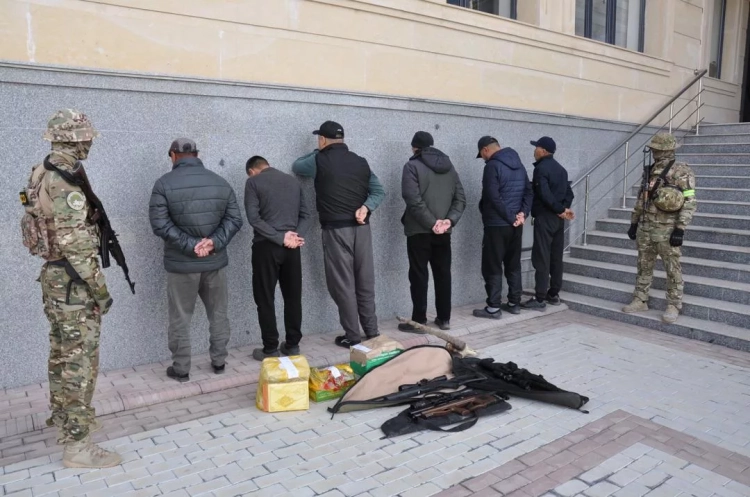
In anticipation of the new school year, from August 21 to August 30, 2014, the annual fair of...

A very sad young man approached the wise elder. - Help me, elder. I have a yurt, but my family is...
Ordo Sakhna – The Folk Ethnographic Theater. Biography. The folk ethnographic theater Ordo Sakhna...

October 12-14 International Beauty Championship From October 12-14, 2018, the most anticipated and...
Russian fans of extreme freeride and backcountry made an introductory video about Karakol and...

Musicians of Kyrgyzstan Create a Unified Creative Community Musicians from various bands in...

On October 15, 2025, searches were conducted in the homes of members of the banned extremist group...

Sabitova Tamara Mikhailovna (1934), Doctor of Physical and Mathematical Sciences (1996),...

Persian Rowan Status: VU. Endemic, ornamental species....

During investigative and operational activities, the fact of receiving 200 thousand US dollars by...

Dog Stinkhorn Mutinus caninus (Huds. ex Pers.) Fr. Status: EN. A decorative species, used in folk...

On October 9, 10, and 11, 2014, the largest international exhibition of cosmetics and perfumery,...

Asian Barbastelle Status: VI category, Near Threatened, NT: R....

Preparations are underway in Bishkek for the II International Theater Festival of Small Forms...
The exhibition features confectionery products, fruits, nuts, and beverages From October 21 to 23,...

A big CASTING is announced! During which, a team of professionals will select the brightest, most...

Kyrgyzstan's team takes first place in the medal standings of the III World Nomad Games A...
Kyrgyzstan is a small country bordering Uzbekistan, Kazakhstan, and Russia. The main attractions...

Pallas’s Fish Eagle Status: V category, Vulnerable, VU, Cl. A species at risk of extinction. One...

Central Asian Tortoise Status: VU Blab (ii, iii, v); Cl. A representative of a monotypic genus,...

Steppe Eagle Status: VI category, Near Threatened, NT: R. One of four species of the genus in the...

Cinereous Vulture Status: VI, Near Threatened, NT. The only representative of the genus in the...

Boronbaev Erkin Kaparovich (1947), Candidate of Technical Sciences (1979), Professor (1995)....

Issyk-Kul Scaleless Osman Status: 2 [CR: D]. Lake form, very rare, critically endangered....
An unusual car has appeared on the streets of Bishkek. Local craftsmen took some parts from a...

Aykol Alikjanova became the winner and holder of the title "Miss World Kyrgyzstan 2014"...
YouTube user Alexey Nikitin previously published a video about the beauty of Kyrgyzstan...

Lynx Status: V! category, Nearly Threatened, NT. A rare subspecies Lynx lynx isabellinus Blyth,...

Kyrgyzstan has been included in the top twenty tourist destinations of 2016 by National Geographic...

On March 29, a beauty contest among married women, "Mrs. Kyrgyzstan 2015," will take...

Acantholimon compactum Status: VU. A very rare narrowly endemic species....
No one has seen Kyrgyzstan from such angles before. YouTube user Alexey Nikitin published a video...

Snow Leopard Status: III. Critically Endangered, CR C2a(i): R, C1....

The company MOTUL, with the support of the Bishkek City Hall and the Federation of Auto-Motorsport...
A Japanese song in the traditional Japanese genre of "enka," titled "Wanderer of...
Residents of the village of Maevka have turned to the Call Center Kaktus.media for help,...

Kyrgyzstan has once again become a priority for Russian tourists. This year, the republic won in...

Bishkek resident Nursultan Alibekov won the online voting of the "Guy of the Month"...

Great Bustard Status: III, Critically Endangered, CR: R, A1. The nominative subspecies Otis tarda...

The video titled "The beauty of Kyrgyzstan" ("Красота Кыргызстана") was...

Eurasian Griffon Status: Category VI, Near Threatened, NT: R. One of two species of this genus in...

Red Wolf Status: III category Critically Endangered, CR: R. There have been no confirmed sightings...

Dzhayran Status: Category III, Critically Endangered, CR: R, Cl. An endangered or possibly extinct...

Ismankulov Almazbek Osmonalievich (1963), Doctor of Medical Sciences (2000) Kyrgyz. Born in...

Murakami at PROMZONA.space “Murakami” is a popular Russian rock band formed in November 2004....

Houbara Bustard Status: III category, Critically Endangered, CR: R, A1. The subspecies Chlamydotis...

Issyk-Kul Marinka Status: 2 [EN: D]. A rare taxon inhabiting Lake Issyk-Kul. Its...

Industry in Kyrgyzstan The leading sector of the national economy of the Kyrgyz SSR became...